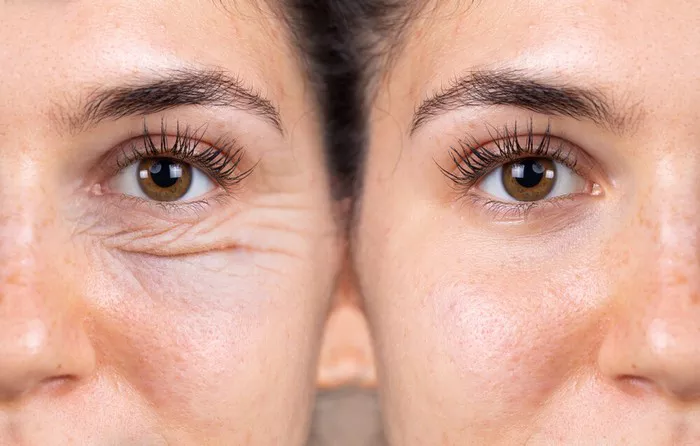Eye wrinkles, often referred to as crow’s feet or laugh lines, are a natural part of the aging process. As we grow older, our skin gradually loses elasticity and collagen, leading to the formation of fine lines and wrinkles. The delicate skin around the eyes is particularly susceptible to these changes due to its thinness and constant facial movements. While it’s impossible to completely reverse the aging process, there are steps you can take to minimize the appearance of eye wrinkles and maintain a more youthful look. In this article, we delve into the factors that contribute to eye wrinkles, explore prevention strategies, and discuss various treatments available to address these common concerns.
Understanding Eye Wrinkles
Eye wrinkles are creases that develop around the outer corners of the eyes, often known as crow’s feet or laugh lines. These wrinkles can be a result of various factors, including repetitive facial expressions, sun exposure, genetics, and the natural aging process. The skin around the eyes is thinner and more delicate compared to other areas of the face, making it more prone to showing signs of aging.
Do Eye Wrinkles Go Away on Their Own?
While some fine lines and wrinkles on the face may appear less noticeable with time, it’s important to understand that eye wrinkles typically do not go away completely on their own. As the skin loses collagen and elasticity over the years, wrinkles tend to become more pronounced. However, there are steps you can take to improve their appearance and prevent further development.
Preventing and Minimizing Eye Wrinkles
Sun Protection:
Sun exposure is a leading contributor to premature aging and the development of wrinkles. Protect the delicate skin around your eyes by wearing sunglasses with UV protection and using a broad-spectrum sunscreen with at least SPF 30 daily.
Hydration:
Proper hydration is essential for maintaining the elasticity and health of your skin. Drink plenty of water and use a hydrating eye cream to help keep the skin around your eyes moisturized.
Healthy Lifestyle:
Adopting a healthy lifestyle that includes a balanced diet, regular exercise, and adequate sleep can contribute to overall skin health. Nutrient-rich foods, such as fruits, vegetables, and foods high in antioxidants, help support collagen production and protect against oxidative stress.
Avoid Smoking:
Smoking accelerates the aging process and damages collagen and elastin fibers in the skin. Quitting smoking or avoiding exposure to smoke can help prevent the formation of eye wrinkles.
Facial Exercises:
Engaging in gentle facial exercises can help improve blood circulation and tone the muscles around the eyes. Be cautious not to overexert the muscles, as excessive facial movements can contribute to the development of wrinkles.
Treatment Options for Eye Wrinkles
Topical Treatments:
Over-the-counter and prescription eye creams containing ingredients like retinol, hyaluronic acid, peptides, and antioxidants can help improve the appearance of fine lines and wrinkles. These ingredients can promote collagen production, hydrate the skin, and provide anti-aging benefits.
Botox and Dermal Fillers:
Botox injections can temporarily relax the muscles around the eyes, reducing the appearance of dynamic wrinkles like crow’s feet. Dermal fillers containing hyaluronic acid can add volume to the skin, minimizing the appearance of static wrinkles.
Chemical Peels:
Chemical peels involve applying a chemical solution to the skin, which exfoliates the outer layer and promotes the growth of new, smoother skin. Peels can improve skin texture and reduce the visibility of fine lines.
Microdermabrasion:
Microdermabrasion gently exfoliates the skin’s surface using a handheld device, revealing fresher, smoother skin underneath. This procedure can help improve skin texture and reduce the appearance of fine lines.
Laser Resurfacing:
Fractional laser treatments can stimulate collagen production and promote skin tightening. These treatments target specific areas of the skin, improving overall texture and reducing the appearance of wrinkles.
Conclusion
While eye wrinkles may not completely disappear on their own, there are effective strategies to minimize their appearance and maintain a more youthful look. Prevention through sun protection, hydration, a healthy lifestyle, and avoiding harmful habits is essential in slowing down the aging process. If you’re looking for more immediate results, consult with a dermatologist or qualified medical professional to explore treatment options like topical products, Botox, dermal fillers, chemical peels, microdermabrasion, and laser resurfacing.
Remember that individual results may vary, and the best approach to addressing eye wrinkles will depend on your skin type, concerns, and goals. By combining preventive measures with suitable treatments, you can achievesmoother, more vibrant skin and age gracefully.

